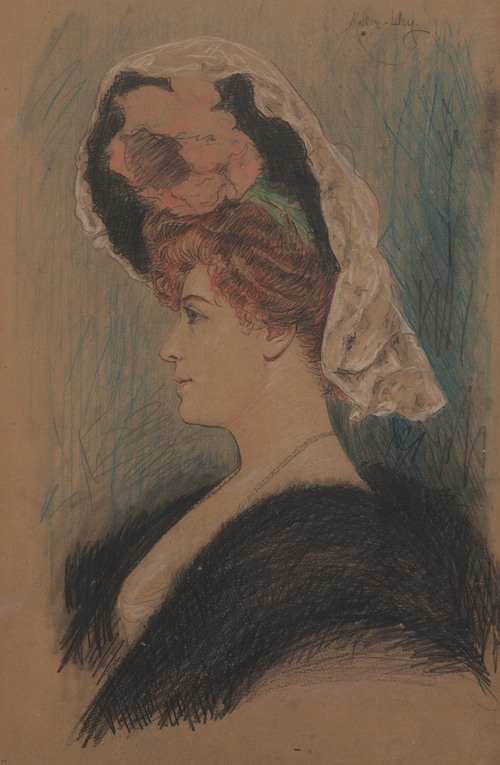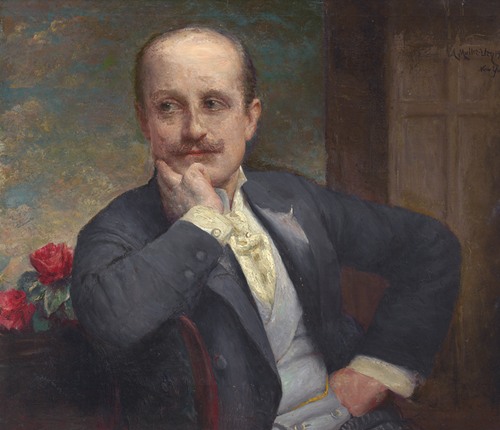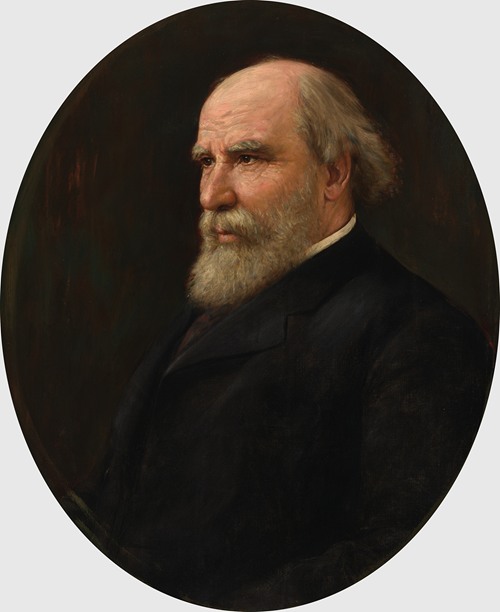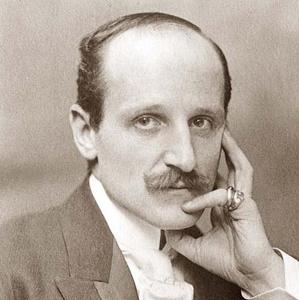





Adolfo Müller-Ury, KSG was a Swiss-born American portrait painter and impressionistic painter of roses and still life.
He was born Felice Adolfo Müller on 29 March 1862 at Airolo, Switzerland, to a prominent patrician family that by the 18th and 19th centuries included mercenaries, lawyers, hoteliers and businessmen.
Adolfo was the sixth of nineteen children, most of whom survived infancy, born to Roman Catholic parents: Carl Alois Müller (1825–1887), a lawyer, was Gerichtspräsident (Presiding Judge) of the Cantonal Courts, and Genovefa (née Lombardi; 1836–1920), daughter of Felice Lombardi, Director of the Hospice on the St Gotthard Pass, which he took over from the Capuchin monks who had run it for centuries. The family spoke Airolese mainly, a local dialect of Ticinese Italian, as well as Swiss-German.
After attending the municipal drawing school in the Ticino, and school in Sarnen he was encouraged by the sculptor Vincenzo Vela (1820–1891) and possibly the Commendatore Metalli-Stresa (a family friend), to study oil painting under the local painter of religious pictures in a Nazarene-style, Melchior Paul von Deschwanden in Stans in Switzerland (who died in Adolfo's arms in February 1881). On April 25, 1881, he entered the Munich Academy, where he stayed 18 months, studying with Professors Alexander Strähuber (1814–82), Alois Gabl (1845–93), Gyula Benczur (1844–1920), and possibly Karl von Piloty; on the same day, a fellow Swiss called Adalbert Baggenstos (1863–97), who originated from Stans, also registered at the Munich Academy.
Between Munich and Paris he spent nearly two years (1882–84) in Rome, studying and copying Old Masters, apparently at the instigation of the distinguished Ticinese-born artist Antonio Ciseri (1821–1891), and where he apparently painted portraits of Cardinals Joseph Hergenröther and Gustav Adolf Hohenlohe who were acquaintances of his uncle Josef, a Domherr in Chur, Switzerland. His known early work is necessarily varied, and includes pictures in the style of Deschwanden (usually signed Müller, Adolfo), academic drawings executed in Munich (usually signed Ad. Müller), copies of Old Masters, and early independent oils, sometimes was influenced by artist's like Robert Zünd (1827–1909) and Frank Buchser (1828–1890) which includes landscapes, genre and religious pictures. Many of these survive in the ancestral home of the Müllers in Hospental, Switzerland, and with surviving members of his family in the St Gotthard and elsewhere.
Whilst in Paris in late 1884 he decided to visit America. He arrived first in Milwaukee, and then visited Chicago and St Paul, Minnesota, where he had relatives. In 1885 he went to Baltimore to paint James Cardinal Gibbons for the first time and in 1886 completed a full-length portrait which was given to the Cardinal for his residence after being exhibited at Schaus's Gallery in New York (missing). At around this time he was travelling all over the eastern United States painting and executed a very large canvas of the Bushkill Falls in Pennsylvania (Von der Heydt Museum, Wuppertal, Germany). Luckily for the artist, his talent for portraiture was soon noticed by the St. Paul railroad builder James J. Hill, who was to commission or acquire many pictures of himself, his family, his friends and business associates, like the Canadian missionary Father Albert Lacombe in 1895, and John Stewart Kennedy the financier in 1901.
In the Newark Museum, New Jersey, is a portrait of a little girl dressed in pink called Miss Brandeis which is probably his first commissioned picture made in America (it is signed with a variation of his family name, A. Lombardi-Muller), though a portrait of Father Joseph Fransioli, who was minister to the large influx of Italian-speaking immigrants arriving in New York, today at the Brooklyn Historical Society, was possibly completed before this as it is signed Adolph Muller. It would seem that from quite early on he wanted to sign his works in a way that was unique to him, and so portraits between 1886 and 1889 are sometimes signed F. Adolphus Muller, A. Muller-Uri, or Muller d'Uri. By 1890 this was fully anglicized as A. Muller-Ury, the umlaut in his surname being dropped. Some of his later smaller works are signed A M Ury. (As late as 1932, the Swiss-American Historical Society published a book on Swiss-Americans where his name was inaccurately stated as Adolph Felix Muller-Uri.) In 1889 he painted a portrait of John R. Brady a New York Judge which was apparently presented to the American Bar Association. He may have travelled in North Africa in the summer of 1889 after visiting the Exposition Universelle as he dated a Portrait of a North African man with a Gun (previously known as Portrait of an Arab; Private Collection, London) that year and exhibited a picture called In the Dark Continent at the National Academy of Design in New York at the end of that year (No. 105; lost). In 1890 he completed a second bust-length portrait of Father Joseph Fransioli of Brooklyn (lost).
His New York studio 1885–1904 was in the Sherwood Studio Building, 58 West 57th Street and 6th Avenue (the building has been long demolished), where he is noted before 1889 in Room C; by 1894 he had a studio with a waiting room (both lit by windows) and a bedroom. Other artists who rented studios in the building in the 1880s were his friend from Munich, Jan Chełmiński (who later married the sister of art dealer Roland Knoedler), landscape painter Robert W. Van Boskerck, James Carroll Beckwith, painter and muralist Edwin Howland Blashfield, and painter turned critic Arthur Hoeber, and later artists such as Carle Blenner and portraitist George Burroughs Torrey. He was photographed in his Sherwood studio by artist turned photographer Edwin Scott Bennett (1847–1915) which was exhibited at the annual exhibition of the Society of Amateur Photographers of New York in 1894.
For a number of years he commuted between New York and Europe. In 1892, after the great success of his portraits of Senator Chauncey Depew in 1890 (Yale Club of New York City) and Mrs Theodore Havemeyer in 1891 (now the property of the Preservation Society of Newport County, Rhode Island), he applied for United States citizenship. It was apparently at this date that he met the young art dealer Joseph Duveen, who was to become a close friend, and after 1891 that he began to be dubbed 'Painter to the Four Hundred', referring the élite of New York society in whose circles he socialized. He was much aided by the Havemeyers, and also by Louis Benziger (1840–1896), a Roman Catholic publisher (Benziger Brothers), who persuaded many New Yorkers to sit to him; he remained friendly with his son Bruno Benziger until his death, and indeed Bruno Benziger organized the artist's burial.
For three years in the late 1890s he leased one of the studios in Pembroke Studios in Kensington, London, where he certainly painted portraits of Donald Smith, 1st Baron Strathcona and Mount Royal, and Lord Mount Stephen who were business associates of James J. Hill, of whom he made an etching in London in 1898 which was distributed to Hill's family and colleagues. According to a letter he wrote to Hill he started the portrait of Consuelo Yznaga, the 8th Duchess of Manchester, in London in 1898, but it is not known if it was ever completed. In 1903 he was one of a group of artists who invested in a new studio building, the Atelier Building, 33 West 67th Street. Muller-Ury lived in the top floor right studio, and incorporated a stained glass panel of the Müller coat-of-arms into the window (removed in 1947 and now at the Haus Müller in Hospental, Switzerland). The floors were all inlaid with borders of intarsia, and the smaller windows given mullions. He moved into the studio in 1904 and remained there until 1947.
In March 1922 he travelled with Sir Joseph Duveen (later Lord Duveen) to California for the first time, in order that Duveen could deliver to bibliophile and art collector Henry E. Huntington Gainsborough's famous picture The Blue Boy which Huntington had bought the previous year. Duveen had promised the artist that Huntington would commission a portrait of himself. He did not.
Müller-Ury liked California and after painting Archbishop Edward Joseph Hanna in San Francisco in 1923 decided the following year to erect a studio near Huntington's estate. The studio he built was at the corner of Monterey and Shenandoah Roads in San Marino (architect Carleton Winslow), in the fashionable Spanish style with a green tiled roof and in the studio an enormous north-facing window. He placed the Muller coat-of-arms on the east frontage, where it may be found today. The gardens were extensively planted with many varieties of roses including Radiance, Columbia, Rose Marie, Irish Charm, Imperial Potentate and American Beauty which he painted into his canvases depicting the Morgan porcelains begun in New York. Duveen built a bungalow next door to the artist on Shenandoah Road, but seems to have quickly sold it after the death of his client Henry E. Huntington in 1927.
After his return from California he settled permanently back in his New York studio. In 1936 he travelled to Europe and he may have done so in 1937 and certainly in 1938 when he painted a large portrait of President Motta of Switzerland, for his home town of Bellinzona (Archivio Cantonale). In 1937 he painted a portrait of Ellen Dunlap Hopkins, founder of the New York School of Applied Design for Women which he presented to the School in 1938 (Private collection, Brooklyn). He painted Pope Pius XII in 1936 during his visit to the United States when still Cardinal Pacelli, only finishing the work in 1939 (by painting in the white robes after his election to the pontificate), and painted his friend Cardinal Francis Spellman of New York twice in 1940 (St Joseph's Seminary, Yonkers) one version being presented by Manhattan College to Fordham University in 1941 (who appear to have lost the work), and again in 1942; he also painted Archbishop Joseph Rummell of New Orleans (1943).
In 1940, he painted the then famous radio soprano Jessica Dragonette (Georgian Court College, New Jersey) and several times thereafter, his last portrait in 1946 depicting her bust-length in a gold fez. In 1941 he produced a portrait of her sister Rosalinda (always called Nadea) Loftus looking over her shoulder. He also painted Dragonette's colleague Fred Mitchell, and several portraits of her friends and acquaintances. In 1942, at age 80, he painted a three quarter length seated portrait of Mrs George H. Ingalls (née Katharine Davis Hinkle), whose late husband, a descendant of one of the founder families of America who had left Lincolnshire in 1628, had been a Vice-President of the New York Central Railroad.
Müller-Ury died, apparently of cancer, on July 6, 1947, at the Lenox Hill Hospital, New York and is buried in New Calvary Cemetery, Queens, New York, where his gravestone is marked simply, if incorrectly, 'ADOLPH MULLER-URY 1862–1947'.
On Thursday, July 10, 1947, a Requiem Mass was held for the artist in St. Patrick's Cathedral. After his death his youngest brother Otto Müller travelled to New York to settle his estate. Most of his studio contents, and a good many of his pictures, were sold in two sales at the Plaza Art Galleries, 28 and 29 November 1947 (No. 2809) and 5 December 1947 (No. 2813), including his oil sketch of Kaiser Wilhelm II of Germany, and the portrait of Lina Cavalieri. The Frick Art Reference Library, New York, has a copy of both catalogues, where the prices for his pictures are marked; three extra lots were included in the second sale.



